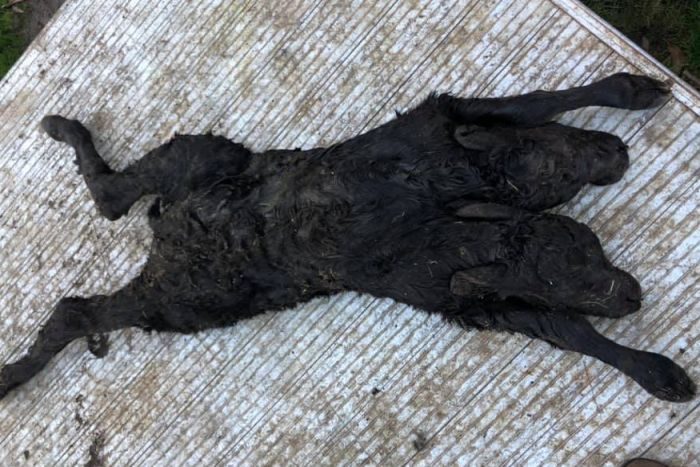
The pure-Angus heifer was a stillborn with two heads, hearts, stomachs and spines and one tail.
It is believed to be caused by a condition called dicephalic parapagus, which is a rare form of partial twinning when the embryo does not split properly during pregnancy.
Another theory points to an inherited genetic condition that causes extra limbs and is passed through certain lines of Angus cattle.
Only seen in photos
The mother gave birth to the twins at the Blyth family's farm in Manypeaks, about 400 kilometres south of Perth.
Farmer Rebecca Blyth said it was a shock.
"It's something we've only seen in photos and heard about," she said.
"It's pretty unusual to be able to pull them out full-term."
On social media, Ms Blythe's husband, Jeff, said he had never seen anything so strange in his 47-years of farming in the area.
While the conjoined twins went the full-term of pregnancy, nearby neighbour and veterinarian, Jess Shilling said survival was improbable because of a hernia in the diaphragm and an incomplete circulatory system.
But the maternal cow is in good health and has become a surrogate mother to another calf.
"She has a new baby and she's very happy with that," Ms Blyth said.
'Incredibly rare'
This is the region's second reported the occurrence of what is believed to be the 'parapagus' condition in recent years.
In late 2016, a set of Speckle Park conjoined twin calves had been born on a nearby farm in Napier.
Ms Shilling said most veterinarians would never see a case in their entire career.
However, the abnormality is more common than expected around the undulated pastures on this stretch of coastline.
"There must be something in the waters because in the four years I've been practising here, I've had two other [unreported] cases of fully-formed Siamese twins," Ms Shilling said.
"I said, 'this is incredibly rare, I am never going to see this again,'. Lo and behold, one season later, I found another one."
Ms Shilling put it down to a strange coincidence.
Developmental duplication theory
It is not known exactly how common conjoined twin calves are.
Esperance veterinarian and former president of the Australian Cattle Veterinarians Association, Dr Enoch Bergman, said rising reports could be attributed to the rise of social media.
"A lot of times these cool things happen, and we talk about them locally, but with social media, when things like this happen ... they get widely disseminated," he said.
However, Dr Bergman still considers the abnormality exceedingly rare.
"It'd have to be a one-in-one-hundred-thousand incident or even more," Dr Bergman said.
Dr Bergman theorised another potential cause to be a condition called developmental duplication, which is inherited through certain lines of Angus cattle.
Affected animals can sometimes be born with an extra limb or limbs.
Life on the land
Whatever the reason, Dr Bergman said it was a rare opportunity to share the reality of life on the land.
"I reckon these things, even if it's a little bit outside of the norm, can still engender some empathy within the city of what we're doing out there in the bush."



Matthew 16-22 (NKJV)
The Pharisees and Sadducees Seek a Sign
16 Then the Pharisees and Sadducees came, and testing Him asked that He would show them a sign from heaven. 2 He answered and said to them, “When it is evening you say, ‘It will be fair weather, for the sky is red’; 3 and in the morning, ‘It will be foul weather today, for the sky is red and threatening.’ [a]Hypocrites! You know how to discern the face of the sky, but you cannot discern the signs of the times. 4 A wicked and adulterous generation seeks after a sign, and no sign shall be given to it except the sign of the prophet Jonah.” And He left them and departed.